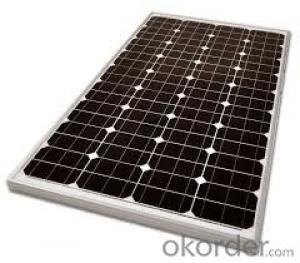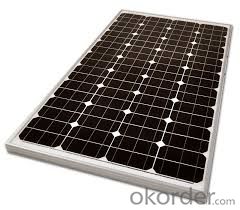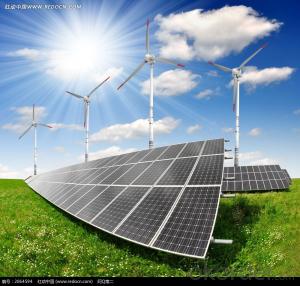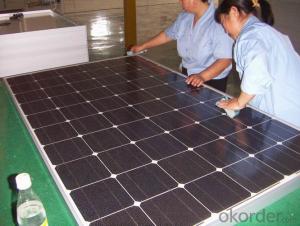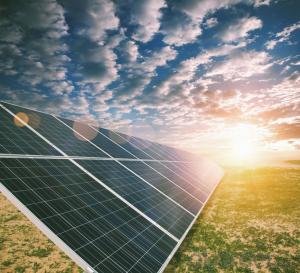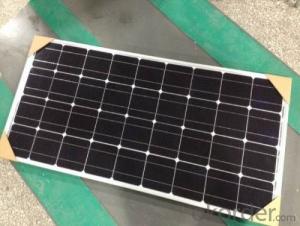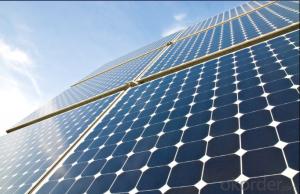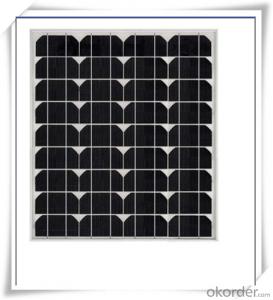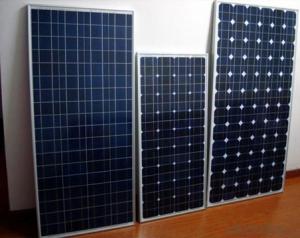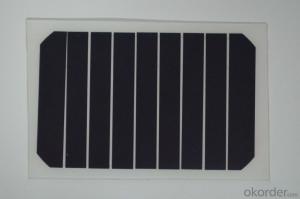Irish Solar Panels - Different Power of Monocrystalline Solar Panel CNBM
- Loading Port:
- Qingdao
- Payment Terms:
- TT OR LC
- Min Order Qty:
- 10 set
- Supply Capability:
- 300000 set/month
OKorder Service Pledge
OKorder Financial Service
You Might Also Like
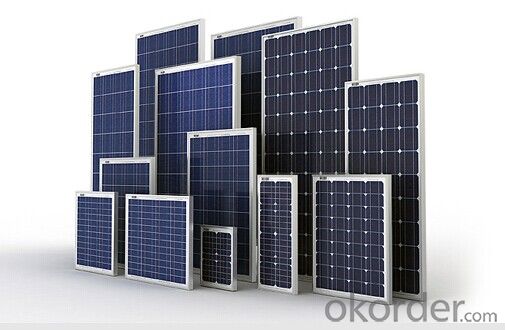
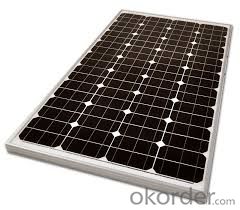
Monocrystalline Solar Modules
We offers a range of small, medium and large monocrystalline solar modules, designed for a range of requirements.
Specifications:
Tolerance | +/- 3% |
Cell | Monocrystalline silicon solar cells |
N0. of Cells | 72 (12 x 6) |
Dimension of Modules (mm) | 1581 x 809 x 40 |
Weight (kg) | 15.5 |
Limits:
Operating Temperature | -40~+85? |
Storage Temperature | -40~+85? |
Maximum System Voltage | 1000 VDC max. |
Hail Impact | Diameter of 28mm with impact speed of 86km/h |
Temperature and Coefficients:
NOCT | 48C+/-2? |
Voltage temperature coefficient (%/K) | -0.34 |
Current temperature coefficient (%/K) | 0.09 |
Power temperature coefficient (%/K) | -0.37 |
Characteristics:
Model: | SGM-160D | SGM-165D | SGM-170D |
Max-power voltage Vmp (V) | 34.5 | 35.4 | 35.8 |
Max-power current Imp (A) | 4.64 | 4.66 | 4.75 |
Open-circuit voltage Voc (V) | 41.75 | 43.6 | 43.32 |
Short-Circuit Current Isc (A) | 5.32 | 5.08 | 5.38 |
Max-power Pm(W) | 160 | 165 | 170 |
Model: | SGM-175D | SGM-180D | SGM-185D |
Max-power voltage Vmp (V) | 36.1 | 36.2 | 36.2 |
Max-power current Imp (A) | 4.85 | 4.97 | 5.11 |
Open-circuit voltage Voc (V) | 43.68 | 43.8 | 44.8 |
Short-Circuit Current Isc (A) | 5.49 | 5.48 | 5.51 |
Max-power Pm(W) | 175 | 180 | 185 |
STC: Irradiance 1000W/m2, Module temperature 25?, AM=1.5
Monocrystalline Solar Panels Specifications Range
Maximum Power (Pm) | Dimension | Weight | Operating Voltage (Vmp) | Operating Current (Imp) | Open Circuit Voltage (Voc) | Short Circuit Current (Isc) |
3W | 158x241x25mm | 0.5kg | 8.5V | 0.36A | 10.5V | 0.4A |
4W | 308x166x25mm | 0.77kg | 8.5V | 0.47A | 10.5V | 0.54A |
4W | 308.x166x25mm | 0.77kg | 16.8V | 0.24A | 21V | 0.27A |
5W | 296x215x25mm | 0.3kg | 16.8V | 0.48a | 21V | 0.54A |
10W | 286x406x25mm | 1.5kg | 16.8V | 0.59A | 21V | 0.66A |
12W | 286x406x25mm | 1.5kg | 16.8V | 0.71A | 21V | 0.8A |
14W | 286x541x25mm | 2kg | 16.8V | 0.83A | 21V | 0.96A |
16W | 286x541x25mm | 2kg | 17.2V | 0.93A | 21.5V | 0.99A |
18W | 296x541x25mm | 2.4kg | 18.8V | 1.07A | 21V | 1.2A |
20W | 296x641x25mm | 2.4kg | 17.2V | 1.15A | 21.5V | 1.24A |
24W | 541x451x25mm | 3.15kg | 16.8V | 1.14A | 21V | 1.56A |
26W | 541x451x25mm | 3.15kg | 17.2V | 1.51A | 21.5V | 1.63A |
30W | 296x966x25mm | 3.85kg | 16.8V | 1.78A | 21V | 2.03A |
36W | 541x641x35mm | 4.7kg | 16.8V | 2.14a | 21V | 2.4A |
40W | 541x641x35mm | 4.7kg | 17.2V | 2.33A | 21.5V | 2.5A |
55W | 1057x457x35mm | 6.6kg | 17.6V | 3.12A | 21.6V | 3.3A |
70W | 546x1196x35mm | 8.5kg | 16.8V | 4.15A | 21V | 4.7A |
75W | 546x1196x35mm | 8.5kg | 17.2V | 4.36A | 21.5V | 4.8A |
80W | 546x1196x35mm | 8.5kg | 17.6V | 4.55A | 21.6V | 4.9A |
110W | 1066x811x40mm | 11.8kg | 17.6V | 6.25A | 21.6V | 6.6A |
150W | 1066x811x40mm | 14kg | 34.4V | 4.36A | 43.2V | 4.7A |
- Q: . The 2v battery will only be turning a small 2v motor that will be turning very slowly yet possibly or a long time. 2. -2 hours max per day it will be running3. I want it to be fully sufficient on solar power once the energy in the battery runs out. What specifications for my panel do you think I will need. However, i have limited space so the smaller the better as long as it can do the jobP.S: I don't know much about electricity and solar power so simple answers please :)
- batteries are rated with the help of the CCA, chilly cranking Amps the better the CCa the longer it is going to very last, don,t imagine you want a charge Controller as your consistently drawing juice from it, the picture voltaic panel will keep the bat at its height , then even as the solar is down , the pump will draw off the bat,
- Q: I want to buy a solar panel kit but I'm unsure of how it works. Basically I want to run my entainment set, Xbox, cable box, 46 led tv, and some desktop speakers. I went online and found a kit for like 250 or something like that at homedepot and was wondering if that kit is worth the money or go bigger or something.
- I okorder to get more information on the subject.
- Q: I had installed over the summer a solar panel system on my house. Hers some infofor you: I live in MOThe system cost 25K (Rounded numbers)The Rebate from the utility company was about 0KThe expected tax rebate will be about 5KI have a home office from which I work and is 5% of my homes sq footage. My question is though I am getting a basic tax rebate, should I be able to claim part of this off as an expense for my home office?It seams logical since I used to deduct part of my electric bill and I there for should be able to write off part of this. I am, after all using electricity and getting a bill from the utility that is higher than it would be if I didn't have the office2. If so which amount should it be? The full 25K or something after the rebates.
- Pretty much stop existing.. Global Warming is Earth's way of pretty much saying..NEXT...We arent causing global warning its time for a change and the earth is doing it.. Mt St helens and also Mt Pinatubo put out more green house gases than anything humans did in history ..Its just a normal trend..Getting ready for the coming of another species.. just like it did with us and we survived ..that should be the question here ,how to survive the earths changes not what we can do about it. There is nothing we can do that will make a difference..Told Decaprio the same thing..
- Q: Can solar panels be used for powering a telecommunications tower?
- Yes, solar panels can be used for powering a telecommunications tower. Solar panels convert sunlight into electricity, which can then be used to power various devices, including telecommunications equipment. This renewable energy option is sustainable and environmentally friendly, making it an increasingly popular choice for powering remote or off-grid telecom towers.
- Q: will at least consider them for their home electricity? I've seen several articles that new technologies are now being used, but it doesn't seem to be promoted to residential apps. I've even seen that the solar technology will be used in paints in the near future.
- As the cost of fossil fuels continues to rise, solar panels become of more value. At one time they were looked on as a rather expensive investment with only a long-term pay off. Now oil is so expensive other sources of power such as wind, solar panels and geothermal energy become relatively cheaper. The efficiency of solar panels is expected to rise so that even in regions where sunlight is limited, these become a realistic investment.
- Q: How long does it take to recoup the cost of solar panels through energy savings?
- The time it takes to recoup the cost of solar panels through energy savings can vary depending on several factors such as the initial cost of the panels, the amount of energy they generate, and the cost of electricity in your area. On average, it can take anywhere from 5 to 20 years to recoup the upfront cost. However, it's important to note that solar panels have a lifespan of 25 to 30 years, so you can continue to benefit from energy savings long after recovering the initial investment.
- Q: Can solar panels be used in areas with high levels of bird droppings?
- Yes, solar panels can be used in areas with high levels of bird droppings. However, regular cleaning and maintenance may be required to ensure optimal performance of the solar panels and prevent any potential damage or obstruction caused by the bird droppings.
- Q: i want to charge my mytouch 3g with solar panel(s) it has a 500mah 3.7v 4.4wh batterieswhat do i need to charge it can i use RadioShack 0.5W Solar Panel 4.5V or RadioShack? W Solar Panel 4.5V
- see u have to make ur own ckt for this ur solar panel generate DC if u want to charge ur phine then its convenient way to harge with ur charger for this do this search for net to convert DC-AC convertor since ur charger work on AC so when ur solar panel generate DC it convert into AC that will charge ur phone in ckt u need this thing filter and amp ie the DC voltage come from solar panel 2 DC to AC convertor 3 AMP for AC 4 filter for AC and u are done....... fine ckt from google.....
- Q: If you buy everything you need for a grid-tied solar set up, can you install it yourself or is it required that a professional installs it?
- For safety purposes and liability, I do suggest that you should hire a professional solar panel installer. The solar panels has a lot of engineered like work, So better hire someone who has a fully aware for this work.
- Q: I am currently building a house, iv designed it to be as self sustainable as possible, I'm in the process of installing solar panels but as I'm ordering online I was hoping someone here could tell me how many I would need to completely run a 5 bedroom home, just standard household appliances such as fridge and freezers, plasma tvs computers and of course lighting, various things like that, also I'll need power storage as well, some type of large rechargeable battery, any help would be great.
- How image voltaic Cells artwork by utilizing Scott Aldous interior this textual content a million. creation to How image voltaic Cells artwork 2. Photovoltaic Cells: replacing Photons to Electrons 3. How Silicon Makes a image voltaic cellular 4. Anatomy of a image voltaic cellular 5. power Loss in a image voltaic cellular 6. image voltaic-powering a house 7. fixing image voltaic-skill themes 8. image voltaic-skill execs and Cons 9. a lot extra advice 0. See all actual technology articles you've likely considered calculators which have image voltaic cells -- calculators that by no skill favor batteries, and from time to time do not actually have an off button. see you later as you've adequate difficulty-free, they look to artwork continuously. you may have considered larger image voltaic panels -- on emergency street indicators or call packing bins, on buoys, even in parking a lot to skill light fixtures. besides the actual shown reality that those larger panels are not so user-friendly as image voltaic powered calculators, they are accessible, and by no skill that frustrating to p.c. out in case you recognize the position to look. There are image voltaic cellular arrays on satellites, the position they are used to skill the electric powered structures. you've likely also been listening to about the image voltaic revolution for the perfect two decades -- the concept quicker or later we can all use free electrical energy from the solar. it really is a seductive promise: On a brilliant, sunny day, the solar shines about a million,000 watts of power in conserving with sq. meter of the planet's floor, and if shall we collect all of that power shall we absolutely skill our homes and places of artwork for free.
Send your message to us
Irish Solar Panels - Different Power of Monocrystalline Solar Panel CNBM
- Loading Port:
- Qingdao
- Payment Terms:
- TT OR LC
- Min Order Qty:
- 10 set
- Supply Capability:
- 300000 set/month
OKorder Service Pledge
OKorder Financial Service
Similar products
Hot products
Hot Searches
Related keywords
